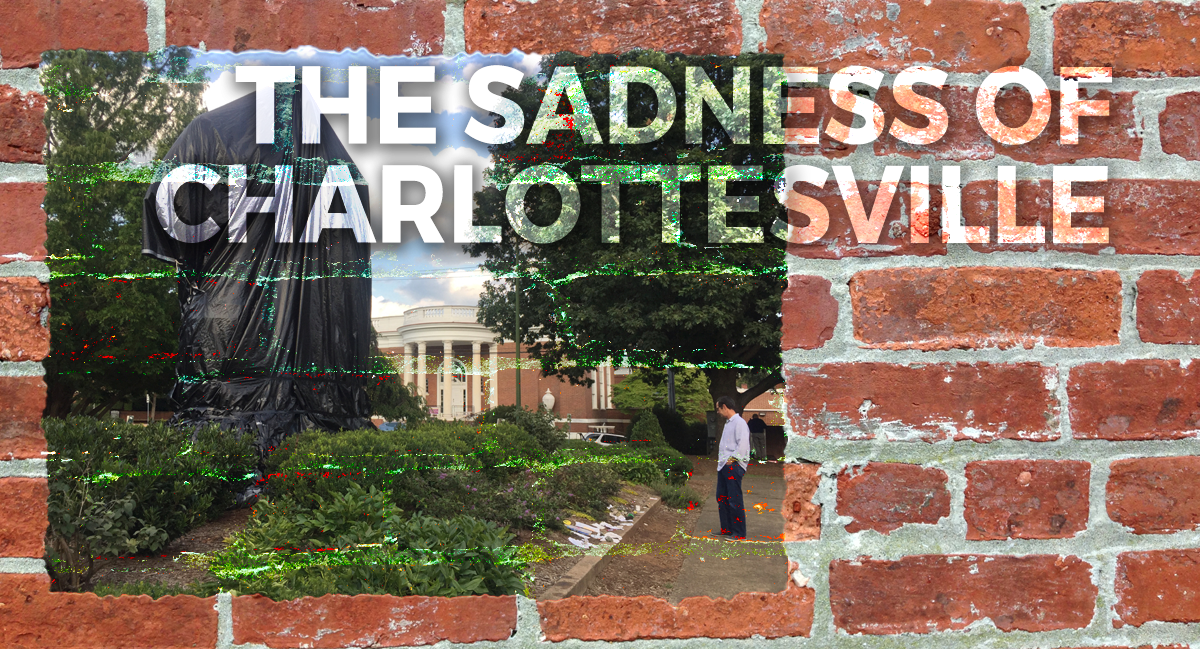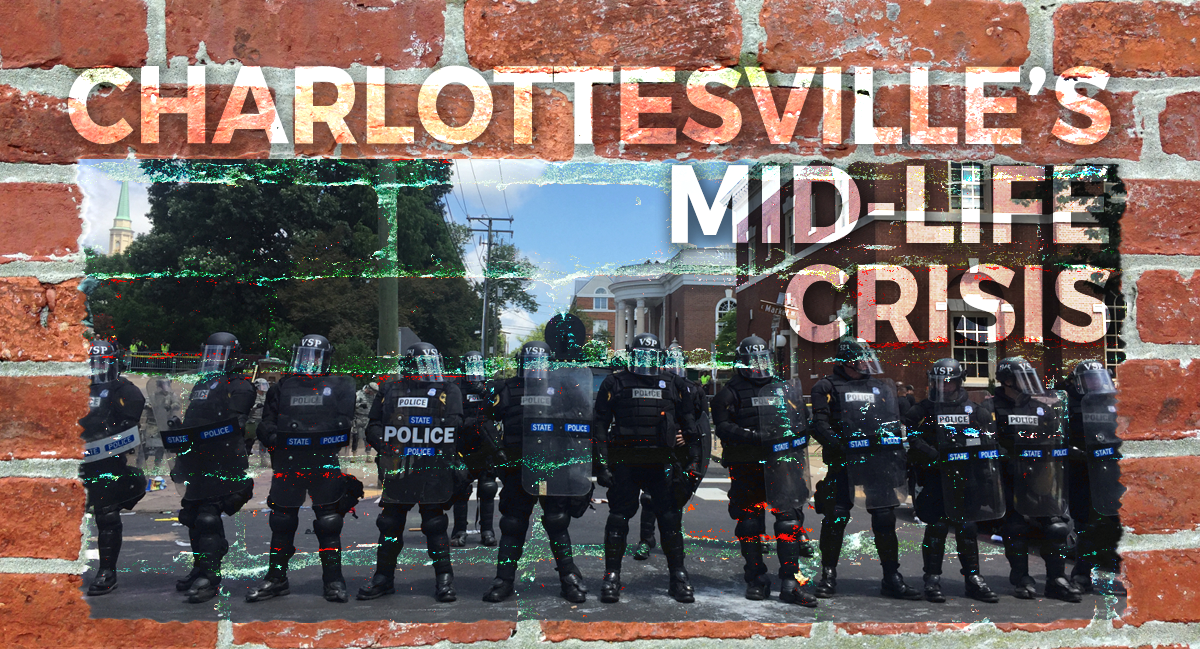There is much to be sad about here in Charlottesville. This past week our City Council voted to shroud our two prominent confederate statues of Robert E. Lee and Stonewall Jackson. The move is intended to be seen as a symbol of mourning over the death of Heather Heyer who was killed when she was struck by a car during the upheaval at the Alt-Right rally earlier this month. Unfortunately, the shrouds look a lot like giant garbage bags which immediately caught traction on social media with those who want these monuments torn down and tossed out like a plate of bad leftovers. A prominent photographer friend of mine posted a picture as the drapes were being placed on one of the statues. He ended his post with these words about Charlottesville… “This is not the place I use to know”. I won’t try and put words in my friends mouth about what exactly that means for him, but there is a bit of that sentiment in the air here.
Let me say that I don’t really consider myself a “Southerner”. I’ve lived in Virginia since 1993 and in Charlottesville since 1995, but I’m a Texan by birth. It’s true that Texas fought as part of the confederacy, but many from Texas are much more “Texans” than they are “Southerners”. As a matter of fact, lots of Texans are Texans before they are Americans, which you’ve probably encountered along the way. Let me also say that in no way am I part of “The South Will Rise Again” movement that we occasionally hear about. My ears always perk up when I hear stories of the secession of Texas (not that it would ever happen), but as Texans we tend to be independent folks who often think we can do things better on our own. BTW, the modern day discussions of secession have nothing to do with slavery, just in case anyone reading this is wondering that in this current climate.
So what do I find sad about the current ongoings?
• I find it sad that the great little city of Charlottesville has become known around the globe for the ugliness of White Supremacy and the ugliness of Antifa. I stood in the midst of both of these groups with a camera on my shoulder and saw some of the ugly parts of humanity. Both of these groups are tiny slivers of society and truly do not represent the great people of Charlottesville.
• I find it sad that “voices of reason” on both sides of the statue debate are totally drowned out by the extreme voices that the media loves to cover.
• I find it sad that the “f” word was used in abundance by many different people in their anger at our recent City Council meeting and that no one with any authority attempted to make the conversation more civil.
• I find it sad that one of our community members lost her life. And I find it sad that the “cause” has turned her name and identity into a rallying cry for their political purposes. Who was she? Most of us never knew her. Was she an artist? Did she excel at sports? Was she strong in math & science? Was she a church-goer? An atheist? Did she love animals? Who was she? Most of us will never know and now she has been immortalized by those who seized the opportunity and have collectively galvanized her into something that probably was only a very minor part of her life. That saddens me.
• I find it sad that more than 150 years have passed since the Civil War ended and that my black brothers and sisters still have to deal with the emotional and psychological chains of slavery. And I find it sad that even when the statues of Lee and Jackson are removed from their parks that the issues of racism won’t go away with the monuments. True, those who feel oppressed won’t have to look at the statues any longer, but all of those white supremacists will still blend into our society. Those who hate people for the color of their skin will still shop in the same stores, eat at the same restaurants, work at the same jobs, and hate with the same hate. The point is that the statues are not the problem… the heart of man is the problem.
• I find it sad that in the progressive little City of Charlottesville we’ve had parks for 100 years with statues of confederate generals, but no one ever worked hard to create a park dedicated to Martin Luther King, Jr. or any other civil rights activists. What would the dialogue in Charlottesville be like today if 40 years ago the city had carved out a park and installed a statue of MLK? He has a performing arts center named after him, but buildings are different than statues.
• I find it sad that those who use this statue as a learning tool to never repeat the mistakes that our forefathers made, will no longer have that opportunity once the monuments are gone. I’m not one that looks at these statues as “heroes of slavery”. When I look at any confederate statue I look with a tinge of pain and grief and I’m also reminded of how lucky I am to even exist in this world. Two of my great-great-grandfathers (non-slave owners) fought for the South (one from Texas and one from Mississippi). The one from Texas left Cherokee County with 6,000 other men… only 600 returned from the war and he was one of them. So I consider myself very fortunate that he even survived, because if he hadn’t I wouldn’t be here. So my sadness about the tearing down of monuments has absolutely nothing to do with slavery. It has more to do with feeling of gratitude I get when I’m reminded of how fortunate I am to be alive in this world.
Ultimately, I believe that within each of us resides both the ability to do great good and the ability to do great evil. We are unbelievably complex creatures and Robert E. Lee and Stonewall Jackson were no different. As a follower of Christ, I try to focus on the good within me and unleash it onto those in society around me, while I try my best (and sometimes fail) to arrest the evil within me before it comes out and wreaks havoc. As Derri Daugherty of The Choir sings in “What You Think I Am”, “I’m nobody’s angel, I’m not that good. I’m no red devil In the wicked wood. I’m a dedicated minister and a downright sinister man. I’m a whole lot better and a whole lot worse than what you think I am.”
A friend from California recently asked me that when these statues come down, as Christians, “shouldn’t we be rejoicing?” I guess I don’t know. I’m sure some will see it that way and I understand their reasoning. As far as rejoicing, I want to rejoice whenever I see my black friends and neighbors accomplish great things. I have several that are filmmakers and artists and I want to celebrate with them in all of their accomplishments. I want to rejoice with the accomplishments of the civil rights movement. I’ve taken all of my kids to Selma, Alabama to walk the Edmond Pettus bridge and I’ve taken them all to Memphis, Tennessee to stare up at the balcony of the Lorraine Motel, because I want to instill in them a love and respect for the work of Martin Luther King, Jr. and all that he did. I also want to rejoice when I see a black father loving on his kids and involved in their lives. They say now that over 70% of African-American’s are born out of wedlock. With statistics like that and the fact that the family unit is the building block of a society I would argue that the issue of “family” is far more important today than the issues of “slavery” and “oppression”, but unfortunately, nobody’s out in our parks and streets marching about that.
This article originally appeared in a slightly modified form as a response to a Facebook post.




